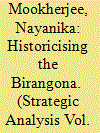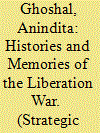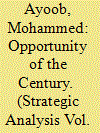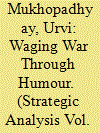|
|
|
Sort Order |
|
|
|
Items / Page
|
|
|
|
|
|
|
| Srl | Item |
| 1 |
ID:
183660


|
|
|
|
|
| Summary/Abstract |
It was hot and muggy on 25 March 1971, with nothing to suggest that the day would turn into an ghastly night. The usual no-work gang were lounging around; my brother was washing the family car and the rest were just doing nothing. This included my banker-father who had been transferred to Karachi on the ground that he had given unsecured loans—small ones—to the wretchedly poor, affected by the cyclone of 1970. He had refused to go and taken leave instead. Like so many of Dhaka’s provincial elite, he was hoping that the matter would be settled peacefully, and he would get an even better job under a new central government with Sheikh Mujibur Rahman’s Awami League (AL) at the helm.1
|
|
|
|
|
|
|
|
|
|
|
|
|
|
|
|
| 2 |
ID:
183664


|
|
|
|
|
| Summary/Abstract |
The article is an observation of the fifty years that have gone by since the liberation of Bangladesh through a guerrilla war against Pakistan in 1971. It spells out the causes behind the military and political collapse of the Pakistan state in Bangladesh, formerly the eastern province of Pakistan. Furthermore, the article is a brief study of the conditions confronting Bangladesh at birth, which at a certain point pushed the country into reverse gear through the rise of illegitimate regimes in the mid-1970s and early 1980s. Finally, the article provides an overview of the current state of politics in the country.
|
|
|
|
|
|
|
|
|
|
|
|
|
|
|
|
| 3 |
ID:
183662


|
|
|
|
|
| Summary/Abstract |
In a fast-emerging multipolar Asia, and in the fast-shifting geopolitics of the area where ostensive national interests are being pursued with growing military-driven intensity, enhancing strategic ties between close and historic neighbours like Bangladesh and India has assumed greater urgency. The region also faces major socio-economic challenges, which were exposed brutally by the Coronavirus pandemic and its effects on lives and livelihood. In such a backdrop, forging closer relations, including enhancing multi-modal and multi-faceted connectivity between the two countries, warrants heightened priority. I strongly believe that Bangladesh and India are best placed to set an example of how increased connectivity in multifarious areas between neighbours and peoples can be immensely and mutually beneficial.
|
|
|
|
|
|
|
|
|
|
|
|
|
|
|
|
| 4 |
ID:
183665


|
|
|
|
|
| Summary/Abstract |
Two decades ago, ‘1971’ was deemed to not have a market within Indian publishing houses and media outlets. Yet, one is struck by the contemporary Indian focus on the iconic figure of the Birangona – brave women, a title given by the State of Bangladesh to women raped by the Pakistani army and their Bengali and non-Bengali collaborators during the Bangladesh war of 1971. It is important to engage with the public memory of wartime sexual violence of 1971 beyond the horrific constructions of the Birangona and the potential for propaganda and geopolitical calculations that the narrative engenders for India.
|
|
|
|
|
|
|
|
|
|
|
|
|
|
|
|
| 5 |
ID:
183666


|
|
|
|
|
| Summary/Abstract |
In the twentieth century, South Asia experienced mass migrations of millions of insecure homeless people twice: it witnessed the Partition-refugees from 1947 and saranarthis during the liberation war of 1971. The Indian State treated the first category as ‘citizen-refugees’, whereas the saranarthis were like temporary shelter-seekers. Among the Northeastern states, Tripura played the most crucial role in providing them with all essential supports. Taken as a case study, this article tries to locate the inner dynamics behind the apparent absorption process in Tripura and it aims to argue that the experience was complex and two-fold in nature for both the communities
|
|
|
|
|
|
|
|
|
|
|
|
|
|
|
|
| 6 |
ID:
183661


|
|
|
|
|
| Summary/Abstract |
Bangladesh’s emergence, as a new nation at the height of the Cold War, in 1971, re-drew political borders in the Indian subcontinent. It was one of the most significant geopolitical events of the latter half of the 20th century. India’s ties with Bangladesh have taken great strides in the last decade in comparison to the first 40 years, expanding and strengthening across a wide template of sectors. This article examines and analyses the drivers that have strengthened bilateral ties and also unresolved issues that remain on the menu as well as developments that have the potential to undermine these growing ties.
|
|
|
|
|
|
|
|
|
|
|
|
|
|
|
|
| 7 |
ID:
183658


|
|
|
| 8 |
ID:
183668


|
|
|
|
|
| Summary/Abstract |
India’s role in the liberation war is often seen through the geopolitical prism. Its response to developments in East Pakistan was complex and evolved over a period of time. Before taking recourse to military action, India exhausted its diplomatic initiatives to draw the attention of the international community to the refugee crisis which arose due to the Pakistan Army-perpetuated genocide – a term first used by India in the Parliament Resolution of 31 March. This article focusses on the debates in the Indian Parliament on the ‘crisis in East Bengal’ that ranged from making budgetary provisions for ten million refugees to building pressure on the Indian government to recognise Bangladesh.
|
|
|
|
|
|
|
|
|
|
|
|
|
|
|
|
| 9 |
ID:
183653


|
|
|
|
|
| Summary/Abstract |
Any history of the Bengalis’ fight for their linguistic heritage and cultural rights cannot be told without a reference to Shaheed Dhirendranath Datta, who played a pioneering role in the formative phase of the Bengali Language Movement. On 25 February 1948 for the first time he demanded recognition of Bengali as one of the state languages of the new nation of Pakistan. He had remained an ardent defender of the Bengali language, both in the Constituent Assembly of Pakistan (CAP) and in the East Bengal Legislative Assembly (EBLA).
|
|
|
|
|
|
|
|
|
|
|
|
|
|
|
|
| 10 |
ID:
183656


|
|
|
|
|
| Summary/Abstract |
The War of Liberation 1971, or the (Muktijuddho), or just Ekkator er Juddho as it is popularly known in Bangladesh, was a People’s War in which all Bengalis participated, sans a few thousands of the country’s seven and a half crores. This was a peoples’ struggle against the undemocratic Government of Pakistan and its oppressive Army. It was a war where ordinary people from all strata of life ― who knew nothing about waging a war ― took up arms against a trained and fully armed Pakistan Army, while many others ― men and women ― contributed in various other ways. This was a War that lasted for only about nine months, but ended in mass destruction and mayhem, killings and rape, blood and tears ― all of which still haunt the people of Bangladesh even after 50 years of independence.
|
|
|
|
|
|
|
|
|
|
|
|
|
|
|
|
| 11 |
ID:
183654


|
|
|
| 12 |
ID:
183663


|
|
|
|
|
| Summary/Abstract |
The year 1971’s geostrategic significance for the Indian subcontinent rivals that of 1947 when British India was divided into India and Pakistan. While the roots of Bangladesh's secession from Pakistan lay firmly within the Pakistani polity, India's political support for the Bangladesh freedom movement and its military intervention were crucial for the liberation of Bangladesh. The Indian campaign for the liberation of Bangladesh was brilliantly conceived and deftly executed. Although humanitarian considerations, especially the influx of ten million refugees into India, played a role the major factors determining the decision to intervene militarily in the Bangladesh crisis were political and strategic in character. This article analyzes these factors as well as the decision-making process that led to India midwifing the birth of Bangladesh.
|
|
|
|
|
|
|
|
|
|
|
|
|
|
|
|
| 13 |
ID:
183657


|
|
|
|
|
| Summary/Abstract |
‘Isn’t it wonderful to be witness to the birth of your country?’ These words were shouted out to my mother and myself by David Vanzant, an international aid worker, just outside the ‘neutral zone’ that was set up in the Hotel Intercontinental in Shahbagh, Dhaka. Crowds were milling around him, and truck-loads of Indian soldiers who had fought their way into Dhaka, alongside troops of Mukti Bahinis (Bangladeshi freedom fighters), shouting ‘Joy Bangla’ at the top of their voices in sheer ecstasy!
|
|
|
|
|
|
|
|
|
|
|
|
|
|
|
|
| 14 |
ID:
183655


|
|
|
| 15 |
ID:
183667


|
|
|
|
|
| Summary/Abstract |
The article takes up the political cartoons printed in newspapers, particularly in Bengali from West Bengal to highlight the popular opinion-base they built in support for Bangladesh and the War of 1971 which perhaps brought a new age in Indian foreign policy where military intervention was upheld as a tool for maintaining peace and security in the region.
|
|
|
|
|
|
|
|
|
|
|
|
|
|
|
|
| 16 |
ID:
183659


|
|
|
|
|
| Summary/Abstract |
In March 1971, I was working on an Oxfam-UK supported Gandhian village development project in Bihar, India, where I had been for almost three years. Through the BBC and some sketchy Indian newspaper reports, I learnt about the unrest in Dacca in the early part of March 1971. Sheikh Mujib’s speech of 7 March was well reported by The Statesman newspaper which always reached Gaya from Calcutta one day late. However, nobody was prepared for what would unfold later that month. Soon after the night of 25 March, Oxfam’s office based in Ranchi in Bihar which, at that time, covered Eastern India and East Pakistan, began to receive reports by telegram from some of its NGO partners near the India/East Pakistan border that hundreds and thousands of refugees were streaming across the border every day. Immediately, some of us visited the border areas, and our reports to Oxfam were so alarming that some people at Oxfam’s headquarters refused to believe the details. One person commented that, ‘Julian is young and inexperienced, and appears to have been affected by the hot Indian sun!’ While reporting the numbers of refugees crossing the border each day, Oxfam’s Head Office officials thought that we, or the telegram operators, had added zeros by mistake ― so 2000 refugees crossing at one border crossing, was thought to mean 20,000!
|
|
|
|
|
|
|
|
|
|
|
|
|
|
|
|
|
|
|
|
|